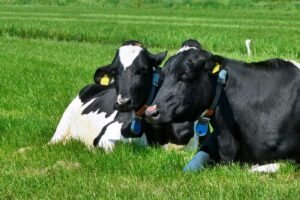Fernando Díaz
Folic acid or folate is a B-complex vitamin that works as a donor and acceptor of one‐carbon units. Thus, it is involved in the synthesis of nucleic acids (DNA) and amino acids (methionine). The name folic acid is deduced from folium (leaf in Latin), because this vitamin was originally isolated from spinach leaves.
Ruminal microorganisms from healthy cows produce enough amounts of folic acid to avoid deficiency. However, previous studies in dairy cows demonstrated that dietary supplementation of folic acid increases milk and milk protein yields. Since microbial degradation of supplemental folic acid is very extensive (more than 95%), rumen‐protected folic acid is usually used for feeding lactating cows.
A recent study published in Animal Feed Science and Technology evaluated rumen protected folic acid supplementation on production performance of mid-lactation Holstein cows. The researchers (Wang et al., 2019) fed a TMR diet with or without 128 g of a protected folic acid supplement (10.0% folic acid; 30.4% ruminal degradability) top dressed daily.
The basal diet [(50% forage/50% concentrate in a dry matter (DM)] included ensiled corn forage without ears (25% DM), alfalfa hay (15% DM) and oat hay (10.0% DM) as forage sources, wheat bran as non-forage fiber (6.0% DM), ground corn (24% DM) for starch, soybean meal (10.6% DM), rapeseed meal (2.5% DM) and cottonseed cake (5.0% DM) as protein supplements, and mineral and vitamins. Protein, fiber (NDF) and non-fiber-carbohydrate concentrations in the basal diet were 16.6, 40.3, and 32.4% DM. Folic acid content, determined by high-performance liquid chromatography, in the basal diet before adding the supplement was 0.34 mg/kg.
As expected, folic acid intake was greater in the supplemented cows (135.0 vs. 7.0 mg/day). Feeding rumen-protected folic acid increased milk and milk component yield. Compared with unsupplemented cows, cows receiving the additive produced more milk (31.8 vs. 28.9 kg/day), fat-corrected-milk (30.9 vs. 27.7 kg/day), milk fat (1.21 vs. 1.08 kg/day) and milk protein (1.07 vs. 0.91 kg/day). In addition, milk protein concentration was higher in cows fed the folic acid diet (3.37 vs. 3.16%). Since DM intake (21.3 kg/day) and body weight were not affected by the additive, cows fed folic acid were more feed efficient.
In conclusion, these findings indicate that addition of rumen-protected folic acid into lactation diets may improve production performance and feed efficiency.
Reference
C. Wang, Q. Liu, G. Guo, W.J. Huo, Y.L Zhang, C.X. Pei, S.L Zhang. 2019. Effects of rumen-protected folic acid and branched-chain volatile fatty acids supplementation on lactation performance, ruminal fermentation, nutrient digestion and blood metabolites in dairy cows.
© 2019 Dairy Knowledge Center, LLC. All Rights Reserved.











